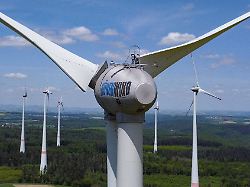Lower Saxony is the frontrunner
There are so many wind turbines in Germany
March 7, 2024, 1:31 p.m
Listen to article
This audio version was artificially generated. More info | Send feedback
Last year, wind power replaced coal as the most important energy source in electricity generation in Germany. Wind energy has benefited from one development in particular: after years of slack, construction is gaining momentum again.
Wind and water instead of coal and nuclear: 2023 was a good year for green electricity generation in Germany. Last year, wind power replaced coal as the most important energy source. Almost a third (31 percent) of the electricity generated in Germany came from wind power, as the Federal Statistical Office announced. Electricity feed-in from wind power reached a new high of 139.3 billion kilowatt hours in 2023.
Wind energy has benefited from one development in particular: after years of lull, the construction of new wind turbines is gaining momentum again. According to the Federal Wind Energy Association (BWE), 745 new turbines with over 3.5 gigawatts of output were built on land last year. This is an increase of almost 50 percent compared to the previous year.
Capacity expanded and plenty of wind
According to BWE, 28,677 wind turbines turned on land in Germany in 2023. At sea there are 1,566. The undisputed leader with 6,169 systems in a nationwide comparison is Lower Saxony. This accounts for 21 percent of all wind turbines. Followed by Brandenburg with 4,039 and North Rhine-Westphalia with 3,610 systems. However, the most construction took place in Schleswig-Holstein in 2023. More than 30 percent or 249 wind turbines have been connected to the grid there. Bavaria, Baden-Württemberg, Thuringia and Saxony will have the least new buildings built in 2023. According to the association, the historically existing north-south divide is further reinforced by the continued low expansion in the south and the high expansion in Schleswig-Holstein.
The statisticians from Wiesbaden also explained that wind energy increased so significantly by saying that capacities were expanded – and there was plenty of wind. The quotas were also affected by the fact that the total amount of electricity generated fell – by 11.8 percent compared to the previous year. The reasons for this: demand in energy-intensive industries was lower due to the weak economy, and the amount of electricity imported from abroad rose significantly by 40.6 percent to 69.3 billion kilowatt hours.
According to BWE President Bärbel Heidebroek, the overall successful ramp-up of renewable energies must be more than just a reaction to external crises. “A legal framework is needed that creates clarity and planning in the long term, even beyond this legislative period. Then the wind energy industry can develop its full potential as a driving economic sector, secure jobs in Germany and contribute to a secure and clean energy supply,” she said .
More uniform requirements for transport permits
Despite the traffic light government’s removal of numerous hurdles, onshore wind energy is still lagging behind its targets. The government target for 2023 was six gigawatts, and for 2024 it is eight gigawatts. Germany wants to cover around 80 percent of its electricity needs from renewable energies by 2030. Industry associations are therefore calling on politicians to implement further, already announced measures to accelerate the expansion of wind energy as quickly as possible.
Heidebroek pointed out that the federal and state governments had agreed on a comprehensive package of measures in November 2023 as part of the Pact for Acceleration. “These resolutions must now be enacted into law as quickly as possible, ideally in the first quarter of this year. Last year, a volume of 7,504 megawatts was newly approved. In order to be able to implement this as smoothly as possible, the course must be set now,” said she. This particularly included predictable and more uniform requirements in the area of transport permits, which are currently delaying projects and making project implementation massively more difficult.
